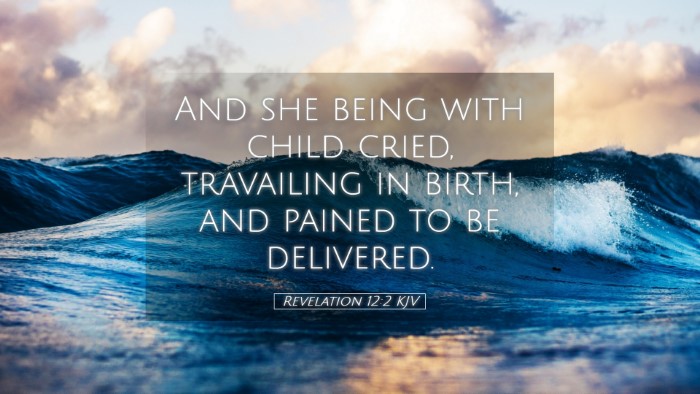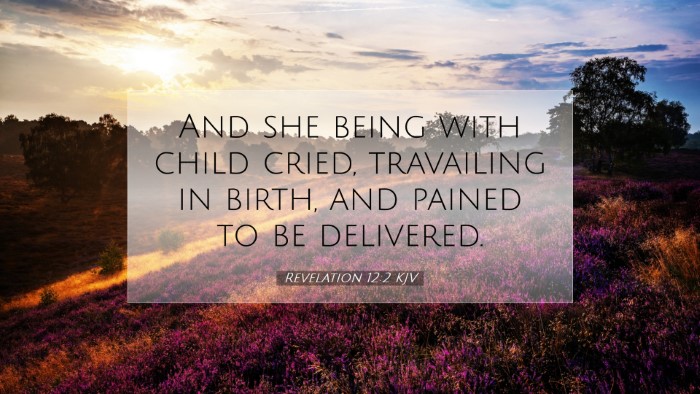Revelation 12:2 Commentary
Verse: "And she being with child cried, travailing in birth, and pained to be delivered." - Revelation 12:2
Introduction
This verse is pivotal in the Book of Revelation, illustrating a significant allegorical representation of the struggle within the Christian faith, conveying themes of hope, suffering, and the eventual triumph of divine purposes. The imagery used here has stirred rich interpretations across theological spectrums.
Matthew Henry's Commentary
Contextual Understanding: Henry suggests that the woman symbolizes the Church, which is often depicted in biblical literature. The condition of being "with child" indicates the Church's state of anticipation for the birth of Christ and, by extension, the believers' desire for redemption.
Travailing in Birth: The term "travailing" conveys intense pain and struggle, akin to the suffering experienced by the followers of Christ as they await His return and the fulfillment of God's promises. This struggle encompasses various tribulations faced by the saints throughout history.
Spiritual Significance: The "child" that the woman bears represents Jesus Christ, whose birth heralds a new era of salvation and divine presence. The travail metaphorically illustrates the challenges faced in bringing Christ to the world, as well as the ongoing afflictions believers endure in their spiritual journeys.
Albert Barnes' Notes on the Bible
Symbolic Interpretation: Barnes interprets the woman as both a symbol of Mary, the mother of Jesus, and as a representation of the Church at large. This duality underscores not only the miraculous birth of Christ but also highlights the broader struggles of Christ's followers.
Pained to be Delivered: The pain associated with delivering the child draws attention to the consequences of sin and the necessity of suffering in achieving redemption. Barnes elaborates on how the Church's tribulations reflect the ultimate sacrifice that Christ made for mankind.
Historical Context: The travailing of the woman serves as a prophetic allusion to the historical persecutions faced by the early Church, reminding believers of the trials endured during the formative years of Christianity. The anticipation of the "child" signifies the hope that lies in Christ's resurrection and ascension.
Adam Clarke's Commentary
Exegesis on 'With Child': Clarke's analysis emphasizes the theological implications of the woman being "with child." He views this state as not only physical but also deeply spiritual, symbolizing the Church's longing for Christ's return and the fulfillment of prophecy.
Travail and Pain: The use of the terms "travailing" and "pained" correlates to the struggles believers face in a world that is often antagonistic toward the faith. Clarke suggests that this imagery serves to encourage the faithful who may feel overwhelmed by their circumstances, reminding them that suffering precedes glory.
Covenantal Understanding: Clarke expounds upon the notion that the woman's experience can be seen through the lens of the Old Covenant, leading to the New Covenant realization in Christ. This reinforces the importance of understanding biblical prophecy and its fulfillment as integral to Christian belief.
Theological Implications
The Role of the Church: The referenced verse encapsulates the Church's mission and struggle in the contemporary world. It serves as an exhortation to remain steadfast in faith, even amidst trials, reflecting the historical context from which the Church emerged.
Hope in Suffering: The imagery of travail emphasizes the hope and assurance that, despite suffering, believers will experience the joy of deliverance—mirroring the birth of Christ, which brought salvation into the world.
Understanding Redemption: By acknowledging the pains of journeying toward spiritual birth, believers can better grasp the notion of redemption as a continual process rather than a singular event, fostering resilience in their faith.
Conclusion
The study of Revelation 12:2 unveils profound insights into the life of the Church, the sufferings of Christ, and the continuous spiritual battle faced by believers. The insights garnered from the public domain commentaries enrich the reader's understanding, providing both historical and spiritual lenses to interpret the text's meaning. As pastors, students, theologians, and Bible scholars delve into this passage, they are reminded of the inseparable link between suffering and hope in the Christian narrative.


